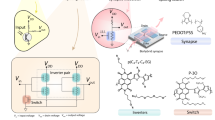Abstract
At present, no satisfactory theory exists to explain how a given molecule results in the perception of a particular smell. One theory is that olfactory sensory neurons detect intramolecular vibrations of the odorous molecule. We used psychophysical methods in humans to test this vibration theory of olfaction and found no evidence to support it.
This is a preview of subscription content, access via your institution
Access options
Subscribe to this journal
Receive 12 print issues and online access
$209.00 per year
only $17.42 per issue
Buy this article
- Purchase on Springer Link
- Instant access to full article PDF
Prices may be subject to local taxes which are calculated during checkout


Similar content being viewed by others
References
Burr, C. The Emperor of Scent (Random House, New York, 2002).
Gilbert, A.N. Nat. Neurosci. 6, 335 (2003).
Maslin, J. The New York Times February 6 (2003), p. E8.
Givhan, R. The Washington Post February 16 (2003), p. X–T8.
Dyson, G.M. Chem. Ind. 647–651 (1938).
Wright, R.H. J. Theor. Biol. 64, 473–502 (1977).
Turin, L. Chem. Senses 21, 773–791 (1996).
Laska, M. & Teubner, P. Chem. Senses 24, 263–270 (1999).
Turin, L. & Yoshii, F. in Handbook of Olfaction and Gustation (ed. Doty, R.L.) 275–294 (Marcel Dekker, New York, 2003).
Laska, M. & Teubner, P. Chem. Senses 24, 161–170 (1999).
Livermore, A. & Hummel, T. Int. Arch. Occup. Environ. Health 75, 305–313 (2002).
Haffenden, L.J.W., Yaylayan, V.A. & Fortin, J. Food Chem. 73, 67–72 (2001).
Watson, W.L., Laing, D.G., Hutchinson, I. & Jinks, A.L. Dev. Psychobiol. 39, 137–145 (2001).
Kobal, G. & Hummel, C. Electroencephalogr. Clin. Neurophysiol. 71, 241–250 (1988).
Acknowledgements
We thank A. Gilbert for expert advice, members of the Vosshall laboratory for comments on the manuscript, and E. Gotschlich, B. Coller and the staff of the Rockefeller University Hospital. A.K. is an M.S. Stoffel Fellow in Mind, Brain and Behavior.
Author information
Authors and Affiliations
Corresponding author
Ethics declarations
Competing interests
The authors declare no competing financial interests.
Supplementary information
Supplementary Fig. 1.
Additive synthesis. Turin suggests that the smell of a mixture of guaiacol and benzaldehyde has a vanilla character not found in its components because the combined molecular vibrations of benzaldehyde and guaiacol roughly approximate the vibrations of vanillin. (a) To test this prediction, subjects rated the vanilla character of benzaldehyde, guaiacol and a 1:1 mixture of both. This is the same experiment as in Fig. 1b but done at lower stimulus concentration (10-4). The benzaldehyde/guaiacol mixture had a vanilla character no stronger than either of its components (N=24, 12 females, 12 males, middle line: median, box boundaries and whiskers: 25%, 75% and 10% and 90% quantiles, respectively; P > 0.05; Student-Newman-Keuls test for multiple comparisons after Friedman's test). (b) In another version of this experiment, odor similarity was rated on a scale from 0 (smells the same) to 10 (smells very different). Subjects did not rate the 1:1 mixture of undiluted benzaldehyde and guaiacol more similar to undiluted vanillin than each individual component of the mixture. The vanillin vs. components and the mixture vs. components values include the comparison between vanillin or the mixture and both benzaldehyde and guaiacol (N=36, 22 females, 14 males) (P > 0.05; Student-Newman-Keuls test for multiple comparisons after Friedman's test). (JPG 37 kb)
Supplementary Fig. 2.
Odor similarity rating of aldehydes. Vibration theory, as formulated by Turin, suggests that aldehydes with an even number of carbon atoms smell different from those with an odd number. We had subjects rate pairs of undiluted aldehydes with eight to eleven carbon atoms for perceived smell dissimilarity. The results show that within-pair smell dissimilarity increased along with the difference in carbon atom number. Odor dissimilarity was rated on a scale from 0 (smells the same) to 10 (smells very different). The three carbon atoms difference includes the pair octanal/undecanal, the two carbon difference includes octanal/decanal and nonanal/undecanal, the one carbon difference octanal/nonanal, nonanal/decanal, and decanal/undecanal (N=36, 22 females, 14 males, middle line: median, box boundaries and whiskers: 25%, 75% and 10% and 90% quantiles, respectively). (JPG 31 kb)
Rights and permissions
About this article
Cite this article
Keller, A., Vosshall, L. A psychophysical test of the vibration theory of olfaction. Nat Neurosci 7, 337–338 (2004). https://doi.org/10.1038/nn1215
Received:
Accepted:
Published:
Issue Date:
DOI: https://doi.org/10.1038/nn1215
This article is cited by
-
Vibration-based biomimetic odor classification
Scientific Reports (2021)
-
A Quantum Biomimetic Electronic Nose Sensor
Scientific Reports (2018)
-
Validity Examination of the Dissipative Quantum Model of Olfaction
Scientific Reports (2017)
-
Differential Odour Coding of Isotopomers in the Honeybee Brain
Scientific Reports (2016)
-
Odorant receptors of Drosophila are sensitive to the molecular volume of odorants
Scientific Reports (2016)



